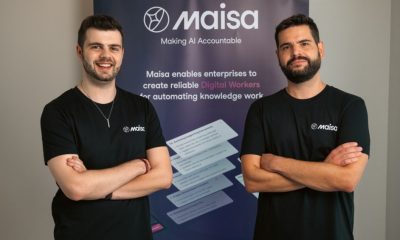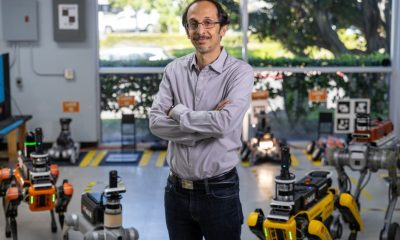Funding
GridCARE Emerges from Stealth with $13.5M to Solve AI’s Power Crisis with Generative Grid Intelligence

GridCARE, a pioneering grid intelligence company, has officially emerged from stealth with a $13.5 million seed round, aiming to solve one of artificial intelligence’s most pressing bottlenecks: access to reliable power. The oversubscribed round was led by Xora, a deep tech venture firm backed by Temasek, with participation from a coalition of climate, AI, and infrastructure-focused investors.
The timing couldn’t be more urgent. The global AI market is projected to reach $757.6 billion by 2025 and grow to $3.68 trillion by 2034, according to Precedence Research. This explosive trajectory is placing unprecedented strain on the world's power grids. The International Energy Agency (IEA) forecasts that electricity demand from data centers will more than double by 2030, with AI leading the charge. The U.S. alone is expected to see data centers account for nearly half of all new electricity demand growth, soon surpassing the energy use of entire heavy industries like steel, cement, and chemicals.
“Power is the new kingmaker in the AI arms race,” said Amit Narayan, CEO and founder of GridCARE. “Companies that secure reliable energy fastest will dominate the next generation of AI. GridCARE gives our partners that critical speed advantage.”
AI-Powered Grid Analysis to Accelerate Data Center Buildouts
Rather than waiting five to seven years for new substations and interconnections, GridCARE enables developers to bring AI infrastructure online in just 6–12 months. The company’s platform uses Generative AI and grid physics modeling to pinpoint underutilized electricity capacity across thousands of utility networks.
This “time-to-power” optimization allows developers to deploy GPUs and CPUs faster—essential in a competitive landscape where the AI model arms race is defined not just by the best algorithms, but by who can run them at scale first.
GridCARE acts as a bridge between utility companies and hyperscalers, simplifying complex, fragmented processes around grid access. Developers can offload the burden of power acquisition while utilities gain new revenue opportunities and better utilization of existing assets.
“GridCARE uncovers previously invisible grid capacity,” said Peter Freed, former Director of Energy Strategy at Meta and now a partner at New Horizon Group. “It opens a new fast track to power, enabling power-first AI data center development.”
From Stanford to the Smart Grid Frontier
GridCARE’s team is steeped in experience at the intersection of energy, AI, and sustainability. CEO Amit Narayan holds a PhD from UC Berkeley and previously founded AutoGrid, a climate-AI company acquired by Schneider Electric. He began applying chip-level signal optimization techniques to the electric grid over a decade ago while collaborating with Stanford’s Precourt Energy Institute.
Co-founders include:
- Ram Rajagopal, Stanford professor and AI-for-energy systems expert
- Liang Min, Director at Stanford's Bits & Watts initiative
- Arun Majumdar, Founding Dean of Stanford’s Doerr School of Sustainability and former VP of Energy at Google
Their collective mission: to unlock strategic flexibility from the grid without building new fossil-fuel infrastructure.
Utilities Embrace GridCARE for Smarter Infrastructure Planning
GridCARE isn’t just popular with developers—it’s quickly gaining traction among utilities like Portland General Electric (PGE) and Pacific Gas & Electric (PG&E).
“The rise of AI presents the biggest new electricity demand surge we’ve seen in decades,” said Larry Bekkedahl, SVP at PGE. “Collaborating with GridCARE enables faster, more confident infrastructure decisions.”
PG&E’s EVP Jason Glickman echoed this sentiment: “Smarter use of the infrastructure we already have is one of the most promising solutions to AI’s energy demands. GridCARE helps us unlock that potential.”
GridCARE also promotes a forward-looking concept known as Power Caching—a localized energy strategy akin to edge computing. Just as edge networks bring frequently accessed data closer to users to reduce latency, power caching co-locates energy generation near AI data centers to reduce grid stress and transmission losses.
By supporting localized generation at the site of consumption, Power Caching improves resilience and eliminates long-distance power congestion—an increasingly common issue in gigawatt-scale AI clusters.
Strategic Backing and Vision for Scale
GridCARE’s backers include:
- Breakthrough Energy (founded by Bill Gates)
- Sherpalo Ventures
- WovenEarth
- Clearvision
- Clocktower Ventures
- AI and energy visionaries like Tom Steyer, Ram Shriram, Balaji Prabhakar, and Gokul Rajaram
Their involvement reflects growing recognition that solving AI’s power crisis will define the next decade of innovation.
“GridCARE has found a solution to AI’s most limiting constraint: energy,” said Phil Inagaki, CIO of Xora. “Their generative AI platform has the potential to reshape how we think about grid access and scale.”
Powering the AI Revolution Starts with Reimagining the Grid
As generative AI reshapes everything from search engines to scientific discovery, the race to scale these models hinges not just on algorithms, but on electricity. GridCARE is stepping in where others are stuck—transforming how power is sourced, modeled, and delivered for the AI age.
With deep tech roots, a founding team shaped by Stanford’s sustainability mission, and a platform that turns gigawatt-scale grid complexity into actionable opportunity, GridCARE isn’t just accelerating infrastructure—it’s laying the foundation for AI’s next leap forward.












